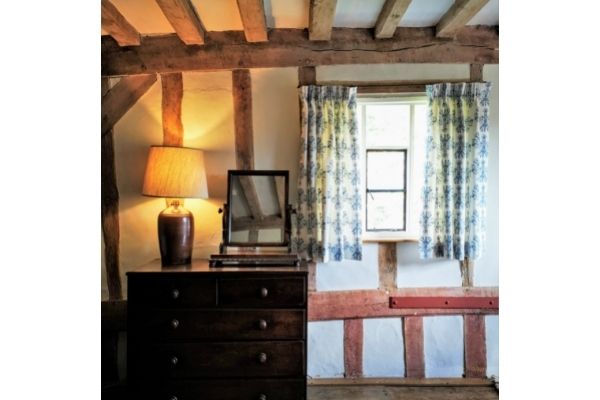Relief housekeeper Duncan Tattersall has continued Lady Smith's work by printing curtains for Landmark. Here he talks about his process at one of our East Anglia Landmarks.
Manor Farm, near Pulham Market in Norfolk, has had a place in the Landmark Handbook since 1982. It is one of those particularly precious buildings among the pages which narrowly escaped demolition, not directly at the hands of Landmark in this instance, but rather those of Monica and Charles Dance of the Society for the Protection of Ancient Buildings (SPAB). They bought the building in 1948 and were responsible for a characteristically sensitive repair of the decaying tissues around its steadfast oak skeleton; a rescue in which “the responsibility of retaining the unspoilt quality in the repair and reconditioning was felt very keenly.”
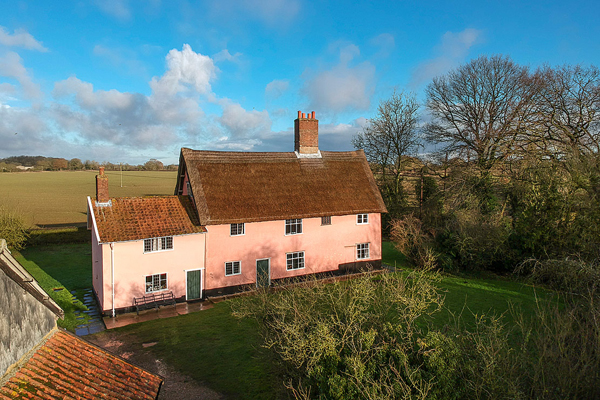
Under their custodianship the house was tenanted, until Landmark purchased it in 1979 to secure its long-term future. Following refurbishment of the Dance’s own repairs of 30 years earlier, Manor Farm was furnished for holiday use in the familiar style now so synonymous with Landmark’s buildings. At the time this was the province of our co-founder Lady Smith, and, as was becoming the trend among the Trust’s properties, she chose to dress its windows with her signature screen-printed curtains. Earlier this year, after four decades of being drawn against unspoilt darkness and pulled back to reveal morning views of farmland by a steady succession of Landmarkers, the time had come for her long-serving curtains to be replaced.
Since becoming involved with designing new curtain patterns for Landmark’s recent restorations like Llwyn Celyn and Cobham Dairy, I have also been tasked with re-printing many of the Trust’s historic designs to keep this tradition of bespoke textiles alive. The process of re-printing always begins with making a copy of the original pattern, most often traced by hand from an existing piece of fabric. Once acquired the motif can then be digitized and resized as necessary to fit the width of the fabric I’ll be working with, and to find the appropriate scale for the curtains in question. As is usual with Landmark’s custom curtains, those at Manor Farm were printed with a motif specifically designed for the house to evoke something of its history.
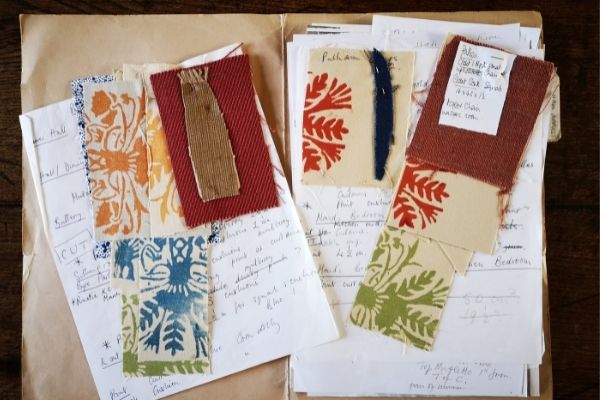
For around 350 years, life for the occupants of Manor Farm was closely attuned to the passing of the seasons and the rhythm of agricultural cycles; a way of life which still has echoes in and around the house today. In autumn, the neighbouring fields glow with golden crops and branches in the orchard sag with russet apples. Even the scent of the longstraw thatch in the farm's attics roots the place in a long-established harmony with the land. Fittingly, the motif on its curtains is a corn dolly.
Corn dollies are harvest emblems with ancient origins, beliefs around which differ between nations and even regionally within Britain. A common narrative however is that upon being displaced from its home by harvest, the corn spirit would retreat into these offerings, effectively hibernating within them until they were returned to the field in the spring as blessings at sowing time. It was tradition to weave these idols from the last cut of corn from the field, with regional variations including the Staffordshire Knot, the Cambridgeshire Handbell, the Suffolk Horseshoe and the Yorkshire Candlestick. The one which graces the curtains at Manor Farm is a Glory Braid, common in East Anglia.
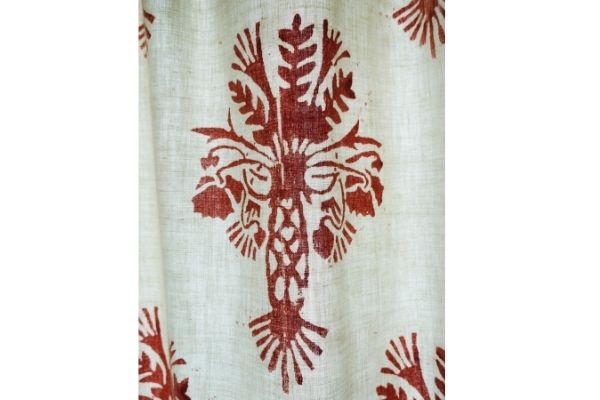
Revisiting an old pattern is an opportunity to consider whether any improvements can be made to its arrangement for reprinting. In this instance, I was asked by Furnishings Consultant John Evetts to bring the motifs closer together, the original curtains having been printed quite sparsely leaving lots of bare fabric. Adapting a tighter repeat helped to bring more pattern and colour into Manor Farm’s otherwise pared back interiors, with a more all-over coverage of the fabric.
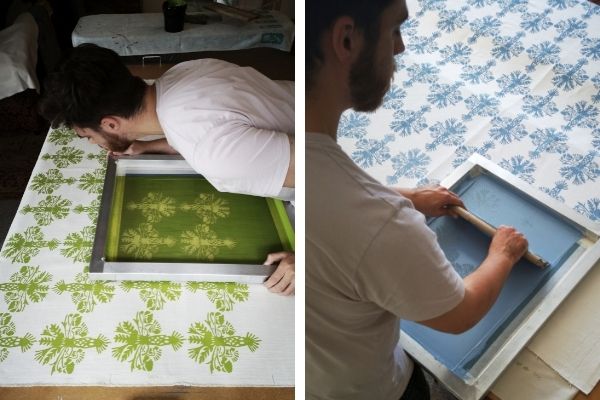
Once the repeat is finalised, the pattern block is exposed onto a screen to become the stencil through which ink is applied to the fabric. True to the small-scale practice established by Lady Smith, I use a 20”x24” screen which I move horizontally and vertically across the cloth to build up the pattern in an almost hypnotically rhythmic process. Each curtain drop is printed individually rather than in a continuous length, helping to reduce waste and manage the accuracy of pattern matching. The alignment is all done by eye, so the result is never as static as a machine produced equivalent, but the quirks and irregularities inherent to the handmade process become a large part of its charm.
For colours, I looked to the existing palette at Manor Farm, and Lady Smith’s original furnishing file for the property now stored at the Honeybourne workshop. This was full of notes and swatches for the initial furnishing in 1982, showing an earthy scheme. I adapted her chosen green and blue to make fresh shades to contrast against the background of oak and limewash in the timbered rooms of the original 16th Century farmhouse. In the later bakehouse addition on the west end of the house, containing today’s kitchen and bathrooms, I mixed a warm pink to compliment the red Norfolk pamment floors and characteristic pink limewashed exterior.
Once all the lengths are printed, the inks set and the fabric washed, I set about sewing the curtains. This is also largely done by hand, with some pairs being interlined to help thermal efficiency in the colder months. It is always a satisfying moment when the long process of design, fabric printing and hand stitching finally comes together in seeing the finished curtains hung in their intended location. The reprints at Manor Farm, with their corn dollies revitalized for another few decades, leave the rooms of this much-loved Landmark refreshed and ready to be enjoyed by the house’s next guests.
